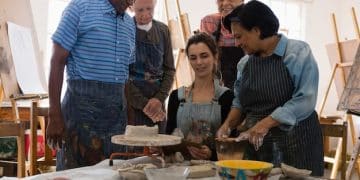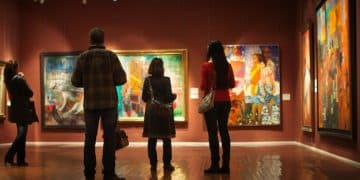Common Art Collecting Mistakes: A Guide for Beginners
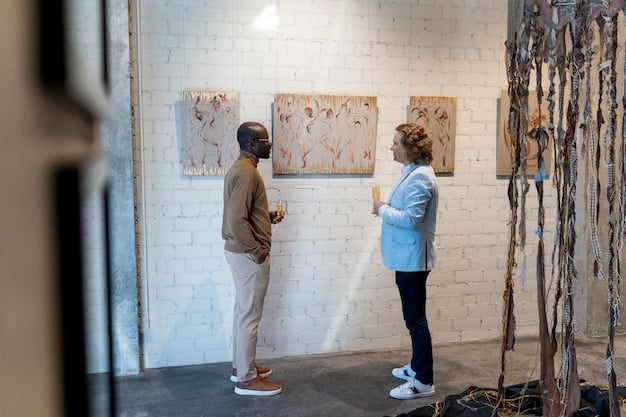
One of the most common mistakes people make when collecting art is not doing enough research, which can lead to overpaying or acquiring fakes; neglecting proper storage and handling is another prevalent issue, causing irreversible damage.
Embarking on the journey of art collecting can be incredibly rewarding, but it’s also fraught with potential missteps. Many aspiring collectors dive in without a clear understanding of the art market, preservation techniques, or their own taste. What are the most common mistakes people make when collecting art, and how can you avoid them? This guide will help you navigate the art world with confidence.
Lack of Research and Due Diligence
One of the fundamental errors in art collecting is failing to conduct thorough research before making a purchase. This includes understanding the artist, the artwork’s provenance, and its market value. Without this knowledge, collectors are vulnerable to overpaying or acquiring inauthentic pieces.
Understanding the Artist’s Background
Knowing the artist’s history, training, and reputation is crucial. A well-established artist with a consistent track record is generally a safer investment than an emerging one with limited exposure. Research the artist’s exhibition history, awards, and presence in reputable collections.
Verifying Provenance and Authenticity
Provenance refers to the history of ownership of an artwork. A clear and documented provenance can significantly increase an artwork’s value and verify its authenticity. Always ask for documentation that traces the artwork’s ownership back to its origin.
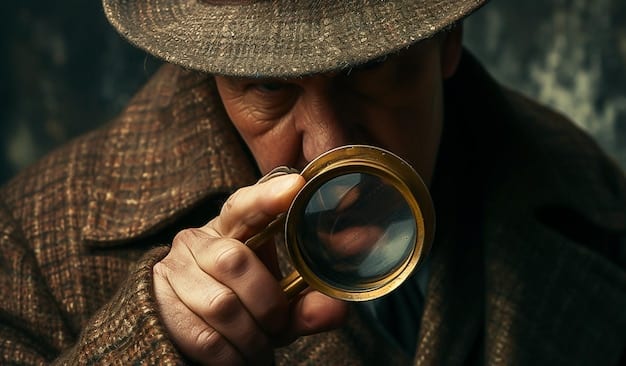
Here are some key aspects to consider regarding provenance and authenticity:
- Request a certificate of authenticity: This document, ideally from a recognized expert, verifies the artwork’s authorship.
- Check for signatures and markings: Examine the artwork for the artist’s signature and any other identifying marks.
- Consult with experts: Engage art appraisers or conservators to assess the artwork’s authenticity and condition.
Failing to research and verify these aspects can lead to costly mistakes, including purchasing forgeries or overvalued pieces. Knowledge is your best defense in the art market.
Ignoring Storage and Preservation
Another common pitfall is neglecting the proper storage and preservation of artworks. Art is delicate and susceptible to damage from environmental factors like humidity, light, and temperature fluctuations. Ignoring these factors can lead to irreversible deterioration.
Controlling Humidity and Temperature
Maintaining a stable environment is crucial for preserving art. High humidity can promote mold growth and cause materials to expand and contract, while extreme temperatures can damage delicate surfaces.
Protecting from Light Exposure
Exposure to sunlight and artificial light can cause fading and discoloration of pigments. UV radiation is particularly harmful. Use UV-filtering glass or acrylic for framed artworks and avoid direct sunlight.
Proper Handling Techniques
Handling art with care is essential to prevent accidental damage. Always wash your hands before handling artworks, and use gloves if necessary. Avoid touching the surface of paintings and sculptures, and lift objects carefully to prevent drops.
Here’s a simple guide for maintaining optimal conditions for your art collection:
- Invest in climate control: Use dehumidifiers and air conditioners to maintain stable humidity and temperature levels.
- Use appropriate lighting: Opt for LED lighting with low UV emissions.
- Store artworks in acid-free materials: Use archival-quality boxes and papers to protect artworks from deterioration.
Proper storage and preservation are not just about maintaining value; they’re about ensuring that future generations can appreciate the artwork as it was intended.
Buying Based on Trends Rather Than Personal Taste
Many collectors make the mistake of buying art solely based on current trends or market hype, rather than their personal preferences. This can lead to a collection that lacks cohesion and personal significance. Art collecting should be a reflection of your unique taste and interests.
The Pitfalls of Trend-Driven Collecting
Following trends can be tempting, especially when certain artists or styles become popular. However, trends are often fleeting, and what’s “hot” today may not be tomorrow. Buying based on trends can result in a collection that feels dated and lacks lasting value.
Cultivating Your Own Eye
Developing your own taste requires time and exposure. Visit galleries, museums, and art fairs to see a wide range of artworks. Read books and articles about art history and contemporary art to expand your knowledge. Trust your instincts and choose pieces that resonate with you on a personal level.
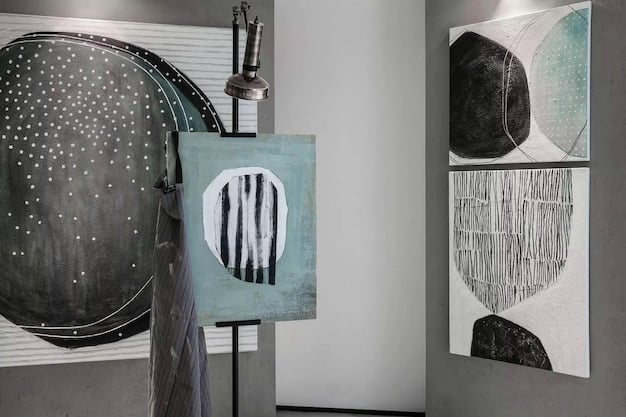
Building a Meaningful Collection
A truly meaningful collection tells a story about your interests, values, and experiences. Choose artworks that speak to you on an emotional or intellectual level. Consider the themes, styles, and artists that you find most compelling.
Here are some tips for building a collection that reflects your personal taste:
- Start with what you love: Choose artworks that you genuinely enjoy, regardless of their market value.
- Explore different styles and mediums: Don’t limit yourself to one type of art. Experiment with different styles, mediums, and artists.
- Trust your instincts: If an artwork speaks to you, don’t be afraid to acquire it, even if it’s not currently trending.
Ultimately, art collecting should be a deeply personal and rewarding experience. Invest in pieces that you love and that bring you joy, rather than simply chasing trends.
Neglecting Insurance and Documentation
Another oversight that collectors often make is neglecting to properly insure their artworks and maintain thorough documentation. Art is a valuable asset, and it’s essential to protect it against loss, damage, or theft. Proper documentation is also crucial for estate planning and potential future sales.
The Importance of Art Insurance
Art insurance provides financial protection against unforeseen events such as fire, theft, or accidental damage. A comprehensive policy should cover the full replacement value of your artworks. Work with an insurance provider who specializes in art and collectibles to ensure that you have adequate coverage.
Maintaining Accurate Records
Keeping detailed records of your artworks is essential for insurance purposes, estate planning, and potential future sales. These records should include information such as the artist’s name, title, date, medium, dimensions, provenance, purchase price, and any relevant documentation.
Here are some key steps to take to protect your art collection:
- Get a professional appraisal: Have your artworks appraised by a qualified appraiser to determine their current market value.
- Update your insurance policy regularly: Review your policy annually to ensure that it accurately reflects the value of your collection.
- Document each artwork thoroughly: Create a detailed inventory of your artworks, including photographs and relevant documentation.
Protecting your investment through insurance and meticulous record-keeping is a crucial aspect of responsible art collecting.
Failing to Establish a Budget
Many aspiring collectors dive into the art market without setting a clear budget, which can lead to overspending and financial strain. Establishing a budget is essential for responsible art collecting and ensuring that you can acquire art without jeopardizing your financial stability.
Setting Realistic Spending Limits
Determine how much you can realistically afford to spend on art each year. Consider your income, expenses, and savings goals. Be realistic about your financial limitations and avoid overextending yourself.
Allocating Funds Wisely
Within your budget, allocate funds for different types of art, as well as related expenses such as framing, insurance, and storage. Prioritize artworks that are most important to you and allocate funds accordingly.
Avoiding Impulse Purchases
Impulse purchases can quickly derail your budget. Before making a purchase, take time to consider whether the artwork aligns with your collection goals and whether you can realistically afford it. Avoid feeling pressured to buy art on the spot.
Here’s a list of considerations for setting and sticking to your art collecting budget:
- Create a detailed budget: List all of your income, expenses, and savings goals.
- Set spending limits for each artwork: Determine how much you’re willing to spend on individual pieces.
- Track your spending: Use a spreadsheet or budgeting app to monitor your art-related expenses.
By establishing and adhering to a budget, you can enjoy art collecting without compromising your financial well-being.
Not Seeking Professional Advice
Navigating the art world can be complex, and many collectors make the mistake of not seeking professional advice from art consultants, appraisers, or conservators. These professionals can provide valuable insights and guidance to help you make informed decisions.
The Role of an Art Consultant
An art consultant can help you define your collecting goals, identify promising artists, and negotiate prices. They can also provide access to private sales and exclusive events. A good consultant will have extensive knowledge of the art market and a keen eye for quality.
Engaging an Art Appraiser
An art appraiser can provide an objective assessment of an artwork’s value. This is essential for insurance purposes, estate planning, and potential future sales. Choose an appraiser who is certified by a reputable organization.
Consulting with a Conservator
A conservator specializes in the preservation and restoration of artworks. If you have concerns about the condition of an artwork, consult with a conservator for advice on proper storage, handling, and treatment.
Consider these ways when seeking professional help:
- Interview potential consultants: Ask about their experience, credentials, and fees.
- Check appraiser certifications: Ensure that the appraiser is certified by a reputable organization.
- Request references: Ask for references from previous clients.
Seeking professional advice can save you time, money, and frustration in the long run, while helping you build a valuable and meaningful art collection.
Ignoring the Importance of Documentation and Provenance
A frequent oversight among collectors is not emphasizing the crucial aspects of documentation and provenance. Art without a clear history or proper paperwork is akin to a ship without a map—its value and authenticity are often questioned, leading to potential devaluation or outright rejection by serious buyers. Understanding where a piece comes from and having the papers to prove it is essential.
Why Documentation Matters
Documentation serves as a lifeline for any artwork. It includes certificates of authenticity, sales receipts, exhibition histories, and any literature referencing the piece. Without these documents, it’s difficult to verify the artwork’s origins and confirm its legitimacy. The more complete the documentation, the more appealing and valuable the artwork becomes.
Steps to Ensure Solid Documentation
When acquiring art, insist on receiving complete documentation. Verify the information provided and keep everything organized. Here’s a list of best practices:
- Request a Certificate of Authenticity: This should be signed by the artist or a recognized authority.
- Keep Sales Receipts: These provide proof of purchase and can be used for insurance and tax purposes.
- Maintain a Record of Provenance: Document the artwork’s ownership history as thoroughly as possible.
By prioritizing documentation, collectors protect their investments and ensure that their artworks can be properly appreciated and valued by future generations.
| Key Point | Brief Description |
|---|---|
| 🔍 Research Thoroughly | Understand the artist, provenance, and market value to avoid overpaying. |
| 🌡️ Preserve Carefully | Control humidity, temperature, and light exposure to prevent damage. |
| 🎨 Personal Taste | Buy art that resonates with you, not just what’s trending. |
| 🛡️ Insure & Document | Protect your investments with insurance and detailed records. |
FAQ
▼
Provenance refers to the documented history of an artwork’s ownership. It’s a record of who owned the artwork from its creation to the present day. A clear provenance adds value and authenticity to an artwork.
▼
To protect your art from fading, use UV-filtering glass or acrylic in frames. Avoid direct sunlight and opt for LED lighting with low UV emissions. These precautions can significantly reduce light damage.
▼
Art insurance protects against loss, damage, or theft. A comprehensive policy covers the replacement value of your artworks, providing financial security in case of unforeseen events. It’s a crucial protection for your investment.
▼
While it’s tempting, buying solely based on trends can lead to a collection that lacks personal significance. It’s better to cultivate your own taste and choose artworks that resonate with you personally, ensuring long-term satisfaction.
▼
Seek professional advice from art consultants, appraisers, or conservators when you’re unsure about the value, authenticity, or condition of an artwork. Their expertise can help you make informed decisions and avoid costly mistakes.
Conclusion
Avoiding these common mistakes can greatly enhance your art collecting experience, ensuring that you build a collection that is valuable, meaningful, and personally rewarding. By prioritizing research, preservation, personal taste, and professional advice, you can navigate the art world with confidence and create a collection that you’ll cherish for years to come.

